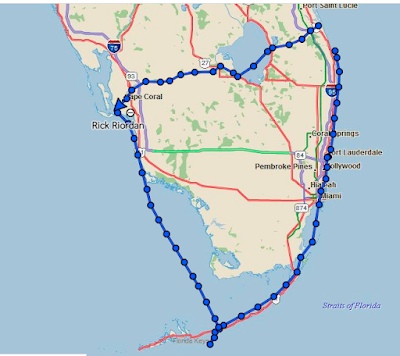 |
| Our Track on the Southern Loop |
The
“Southern Loop” route is a (very) miniature version of the Great Loop covering
about 460 miles via a largely circular path around the southern third of
Florida. While it can be attacked in
either direction, we headed upriver from Fort Myers to Clewiston on Lake O,
then to Stuart, down the east coast to Fort Lauderdale, thence to Marathon in
the Florida Keys, and finally back home going up the west coast of the state. We were one of five other boats from our
local Grady-White club, most of whom were new to both the brand and extended
cruising.
Wed, 18-May, Fort Myers to Clewiston
Compared to the other five boats in our small fleet, this was a short leg for us. They had to run nearly two hours south from Punta Gorda to reach the mouth of the Caloosahatchee River, whereas that’s where we were starting. Nevertheless, all had to traverse three locks enroute to Clewiston on Lake Okeechobee, so combined with several go-slow no-wake zones along the way, it still took about five hours to cover the 70+ miles to Roland Martin Marina on the southern shore of Lake O, arriving around 1500.
 |
| Our Small Fleet Heads Upriver |
By now Roland Martin’s has become a historic fixture on the Okeechobee Waterway, and a very convenient halfway stopover point on the inland route across the state of Florida. Docking is dead-nuts simple on their long stretch of floating dock, their outdoor Tiki Bar serves up decent food and drink at reasonable prices, and they have an onsite (although modest) motel for boaters needing accommodations. (We were the only cabin boat in the fleet, so that was an important marina feature on this Loop journey.) It’s location between the lake and the Everglades, however, demanded generous amounts of Deet as sunset neared.
Parallel Parking at Roland Martin's Floating Dock
Thu, 19-May, Clewiston
to Stuart
A flood control gate separates Roland Martin’s from Lake O and for some unknown reason it was closed as we prepared to depart the following morning; but by 0930 we were finally underway again. The 25 mile trip across Lake O was a smooth cruise and passing through the lock at Port Mayaca was as easy as it gets – straight through with no water level change. Unfortunately the railroad lift bridge on the east side of the lock was just lowering to accommodate a passing train (after many crossings, a first for us), so we still had to loiter for about 20 minutes. (Interesting side note: that lift bridge can raise no higher than 49 feet above normal water level, making it the limiting factor for vessel air draught when transiting the Okeechobee Waterway.)
The Mayaca RR Lift Bridge Being Lowered
We
saw quite a bit of boat traffic on this leg of the journey, most of it headed
east as well. We came upon a low-moving
trawler at one point on the St. Lucie River, and in exchange for a slow pass
(which we would have provided regardless) its skipper offered to take photos of
our small flotilla. He made good on his
word and posted them to Google Pics at this LINK.
By the time we arrived at the last lock around 1230 (St. Lucie) and its 14-foot water level drop we had eight boats wanting to transit….it was a tight fit but we got all eight squeezed in and locked through. We arrived in Stuart and Manatee Pocket about two hours later, but before proceeding to dock at Pirate’s Cove Marina we stopped about a quarter mile short to take on fuel at Sailfish Marina – mainly to avoid queuing up with all the others at the marina fuel dock. And nothing quite illustrates the cost of boat ownership as much as pumping 150 gallons of 90 octane ethanol-free fuel into your tanks in an inflationary economy.
 |
| Squeezing Eight Boats Into the St. Lucie Lock |
We enjoyed a group dinner together at the marina restaurant, and given the iffy weather forecast for the next day agreed on an earlier start for the next leg to Fort Lauderdale.
Fri, 20-May, Stuart to Fort Lauderdale
To this point our weather had been very good – hot and humid to be sure, but mostly sunny and storm-free. However, the weather guessers were anticipating a fairly stormy day for Friday, so in cloudy but dry conditions we pushed off from Pirate’s Cove around 0800, pointing the bow towards the St. Lucie Inlet and the open Atlantic Ocean. And it got a little bumpy.
There was a brisk wind out of the southeast and seas were running around four feet with a healthy wind chop on top. Normally we would have slowed down a bit when punching into a head sea, but we could see several clusters of storms both on radar and on the boat’s XM weather displays, all moving towards us from the ESE…so we kept the throttle up. While most of our Grady formation was attempting a single-file formation, we wanted no part of that yo-yo effect – so we steered Ghost Rider into a fanned out echelon position on the lead boat, set the trim tabs to lower the sharp bow into the waves, and punched the autopilot heading-hold. That made for a relatively stress-free ride in spite of the short period square waves and occasional rain shower.
Our Track Down the East Coast Has a Gap in it Just South of
Stuart....Because We Forgot to Turn On the Tracking Device.
The fleet took a down day on Saturday and remained in port. Wind and periodic storms made any potential fishing sorties unappealing, so Rick just chilled and relaxed and putzed around the boat, while Chelle launched off on some walking & shopping expeditions with the gal pals. That evening the nasty weather finally cleared and we got to spend some time with Milt and Judy Baker, fellow ex-Nordhavn owners. Milt is also the founder and (still) the chief moderator of the Nordhavn Owner’s Group (aka NOG) where Rick is also a co-moderator. They brought along a bottle of wine which we enjoyed aboard Ghost Rider, and were treated to good pizza at one of their favorite local haunts.
Our Grady-White Fleet Lined Up at Bahia Mar
Sun, 22-May, Fort
Lauderdale to Marathon
The winds were still whipping around the following day, churning the open Atlantic into a washing machine, so we reluctantly agreed to take the “inside” ICW route on the sortie south to Marathon, with a 0900 departure. The portion between Lauderdale and Miami was, to nobody’s surprise, an absolute slog….that 26 mile stretch required nearly three hours to traverse before we got into Biscayne Bay. From there it was another three hours to cover the next 90 miles to Marathon in the mid-Keys.
 |
| The "Inside" (ICW) Route from Lauderdale to Miami is a Lot of This.... |
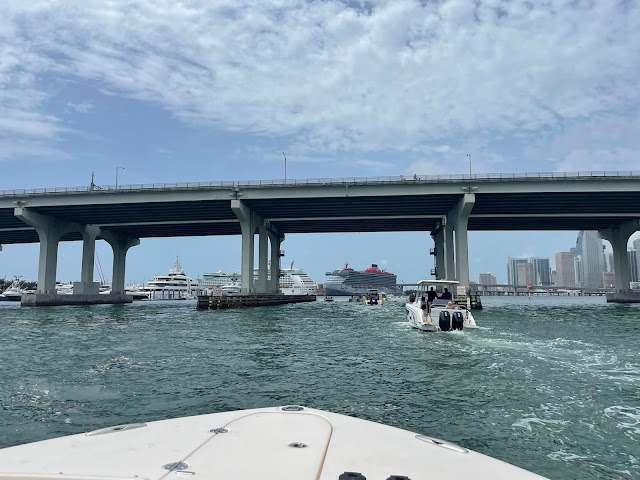 |
| ....And This.... |
Unfortunately once we arrived at the entrance to the Banana Bay Marina, we could not raise any response on VHF or by phone for more than 30 minutes; since its marina basin is fairly small it was a “one-at-a-time” docking procedure, so it took a while longer to get situated. This was our first visit to Banana Bay, and their fixed wooden docks and power pedestals were in excellent condition; unfortunately we couldn’t say the same for their transient showers & restrooms – those are in dire need of a tear down and rebuild. Supposedly that is on their renovation schedule for some time in the future.
The Banana Bay Marina Basin is a Little Snug but Slip Space is Generous and the
Fixed Wooden Docks are in Excellent ConditionGhost Rider All Tucked in at Banana Bay
The sea forecast for the next two days was fairly awful – four-to-six feet with continuing blustery winds, but we were now well clear of convective activity and enjoyed abundant sunshine. On Monday we decided to venture out anyway for an attempt at offshore mahi fishing, setting out around 0915. Ron Ingram from buddy boat Open View joined us as a third crewmember as he had never gone trolling before. We cut under the Seven Mile Bridge at Knight’s Channel and stopped at Burdine’s fuel dock to fuel up (200 more gallons) and take on a load of ice for the fish box. The old timer manning the pump gave us a quizzical look and warned that we were headed into “very nautical” conditions; but he indicated the fishing had been good lately.
 |
| Ron and Our $1200 Mahi |
Ron did a great job bringing the fish to the boat in some pretty lousy conditions, but understandably was starting to feel a little queasy in the lumpy seas. So not wanting to ruin the day, Rick cut the sortie a little short and we ran back to the smooth waters on the bay side, docked up back at Banana Bay around 1400, and enjoyed a cold celebratory beer.
As it turned out we had caught the only fish that day. Chelle cleaned and fileted it, Rick grilled it, and we enjoyed some very fresh mahi that night for dinner on the boat.
Wind and seas were just as ugly the next day, perhaps even a bit worse, so we enjoyed another down day, biding time at the waterside bar and swimming pool, and prepping for the long ride home the following day.
 |
| Chelle Making Filets from Our Mahi Catch |
 |
| Poolside Portrait at Banana Bay....Fearless Flotilla Leader, Fred, in the Foreground, the Remainder Clustered in the Background |
Wed, 25-May, Marathon
to Fort Myers
We cast off at 0800 the next morning and headed north. About halfway through Florida Bay the continuing stiff southeast wind had churned up quite a washboard ride, but that eased considerably once we got around Cape Romano Shoals and tucked in close to shore near Marco Island. By now our small fleet of Grady-White’s had learned the benefits of fanning out into an echelon formation vs. suffering the accordion effect of single file, and that was good to see. Apart from the breeziness, the weather was otherwise fine with partly cloudy skies and temps in the mid-to-upper 80’s. We were back at our home dock by 1330, covering the final 140 miles of the Southern Loop in 5.5 hours.
The Grady Fleet Scoots for Home on the Last Leg of the Loop
Aftermath
On the day we returned home from our eight-day trek around southern Florida, Rick came down with Covid-19. Even with four shots of the Moderna vaccine, it kicked his butt, the worst of it being a wicked sore throat for about five days. (“Death by a thousand swallows.”) As far as we know, nobody else in our group developed any symptoms.
As for the boat, Ghost Rider performed fairly well, with only a few annoying caveats. With all the salt water we took over the bow (and occasionally over the hard top) we definitely found some water leaks; one appears to be along the rub-rail seam; another was through a loose wiper motor mount; and another might have been due to several under-torqued bolt/nut attachments that secure forward parts of the helm superstructure.
Two LED rope light sections in the forward cabin failed; one was just a loose connection, the other was a failed string; tearing apart parts of the interior to repair those was how we found some of the water leak sources. A ceiling mounted LED light fixture in the helm area also partially broke from its spring tension mount (fixed with some Life Caulk.)
Finally, on the last leg home the Yamaha engine computer reported some unknown and very unspecific error for the starboard engine – no details whatsoever were available in the computer’s log, and the engine continued to run flawlessly. A reboot (a shutdown followed by battery switch cycling) cleared that up, likely just a transient voltage issue not handled by the firmware. And lastly, the Garmin VHF radio would not power up on the final day – that turned out to be a separated bullet connector in the power wire underneath the electronics box; easily fixed and reinforced to prevent future occurrences.
Some pertinent pics follow at the bottom of the blog entry.
And Then the Tropics
This year’s hurricane season didn’t waste any time getting started. A Cat-2 hurricane plowed into the west coast of Mexico in late May, fell apart as it crossed the isthmus, then tried to reform in the Gulf of Mexico in early June, while taking aim at our area in southwest Florida. A lot of upper-level windshear has been keeping it disorganized, and at most just a major rainmaker for us. Nonetheless we spooled the boat high on its lift and attached several extra anti-sway lines to guard against surge and wind gusts. The disturbance did not make tropical storm status (“Alex”) until it had passed well to our east.Upcoming
If Rick can manage to pass the required Covid test, next up is a trip to the Bahamas planned for 8-Jun to 16-Jun. Going from here to Key Largo, Bimini and Chubb Cay – and hopefully some fishing there – is the general plan. We’ll keep y’all posted on how all that goes.
The Lack of Details on This Engine Error Message Was More Annoying Than the Error After Removing the Cabin Ceiling Panel We Had Access to its Rope Lights (Red Arrow), the Wiper Motor (Green Arrow), and Three Bolt+Nut Attaching Points (All of Which Were Loose.) Close-up of One of the (3) Loose Nuts...Required a 13/16" Deep Socket to Tighten Shot of the Completed Repairs with Cabin Ceiling Back in Place.








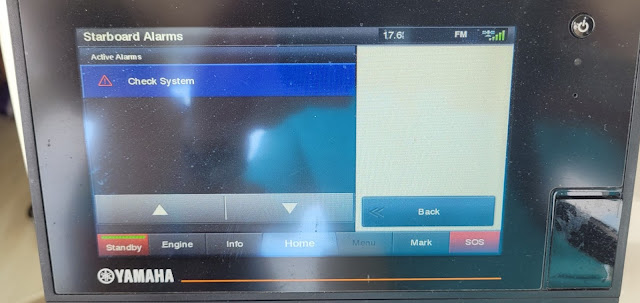
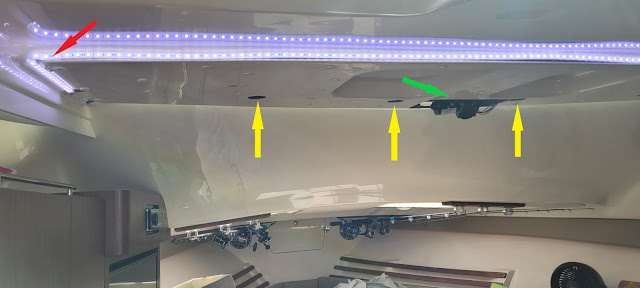



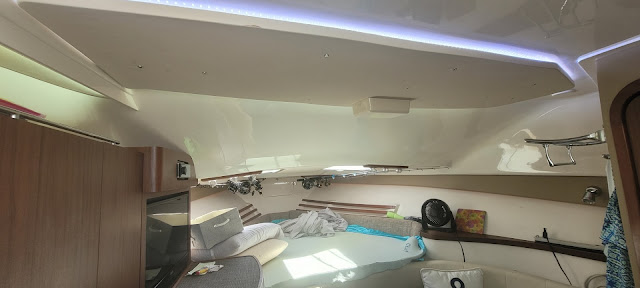
I'd been waiting for this...Sorry the winds honked for much of the trip. Funny...I was looking thru Fred's FB pics of the Loop and subconsciously noticed the RR Bridge down a little from where it always has been during our sorties. I didn't give it much thought until I came across the Blog Section where you described waiting for the train. That Helm Master likely came in handy for station-keeping while you lingered in the middle of the Waterway.
ReplyDeleteYikes; sorry you got tagged with the Virus. Hopefully it's in the rear view mirror before you guys depart again. I thought that crap was going away....
Thanks again for another informative & entertaining piece. Props to the Author....
I do love the Helm Master’s stay-point function, very convenient; learned something new on this trip….it activates flashing lights on the transom when engaged, sorta like backup lights on your car. As for the virus….can’t imagine encountering that beast without the assistance of the 4 vax shots.
ReplyDeleteHugs to Terri.